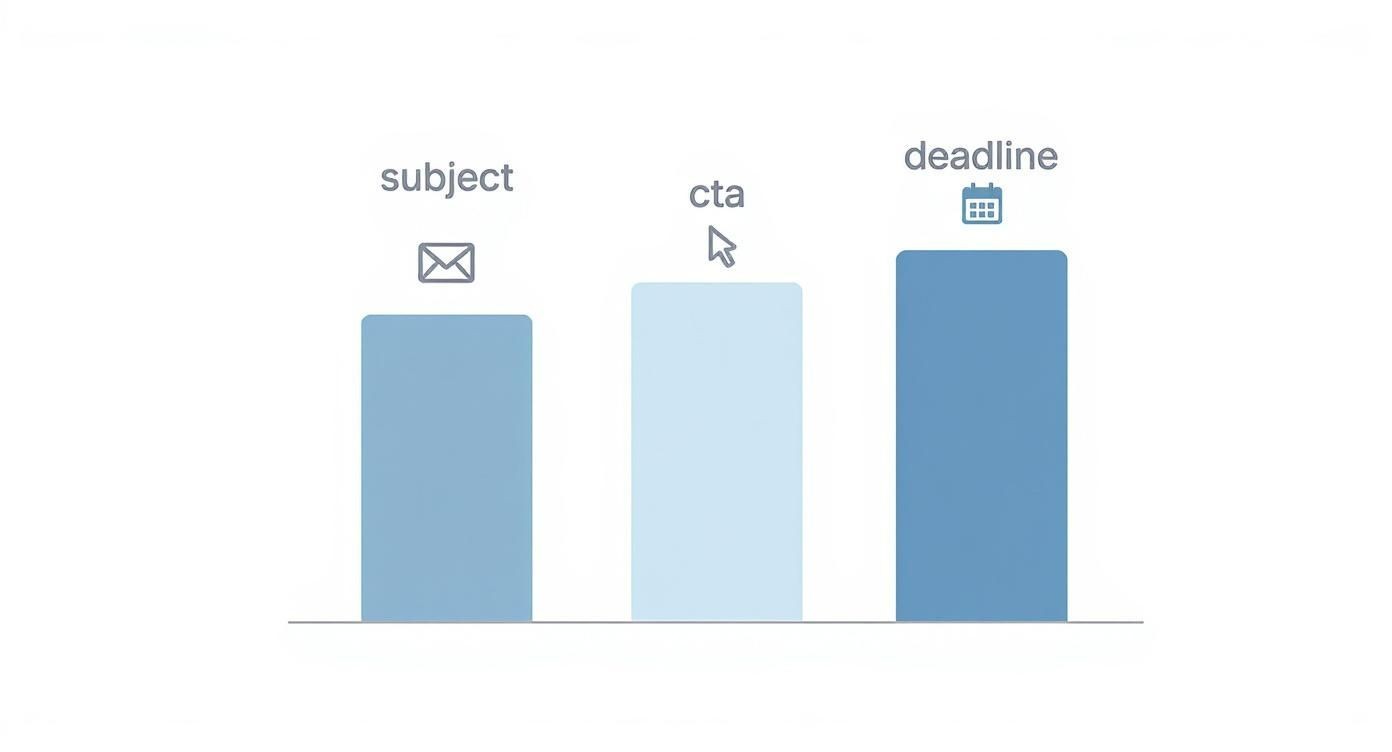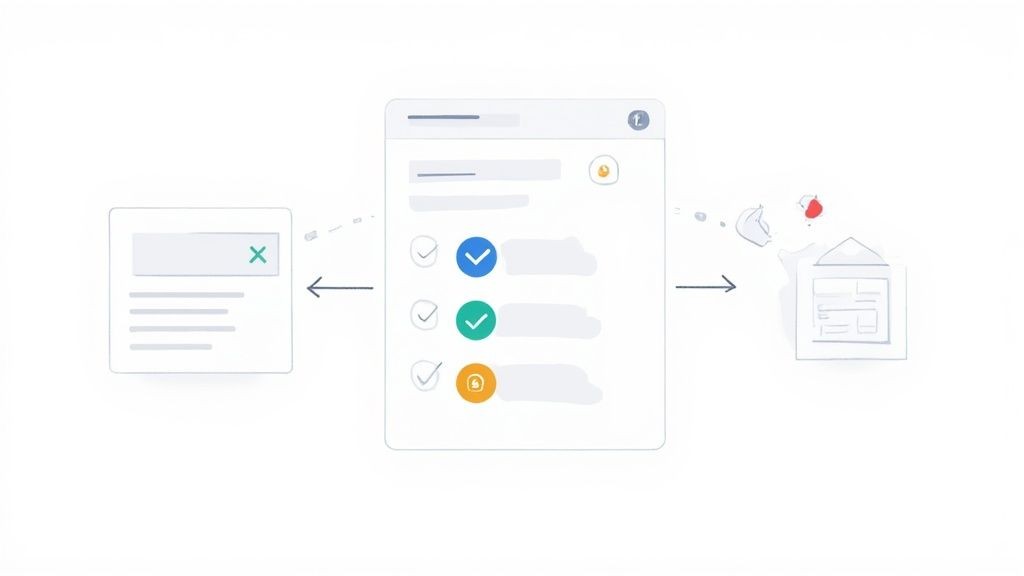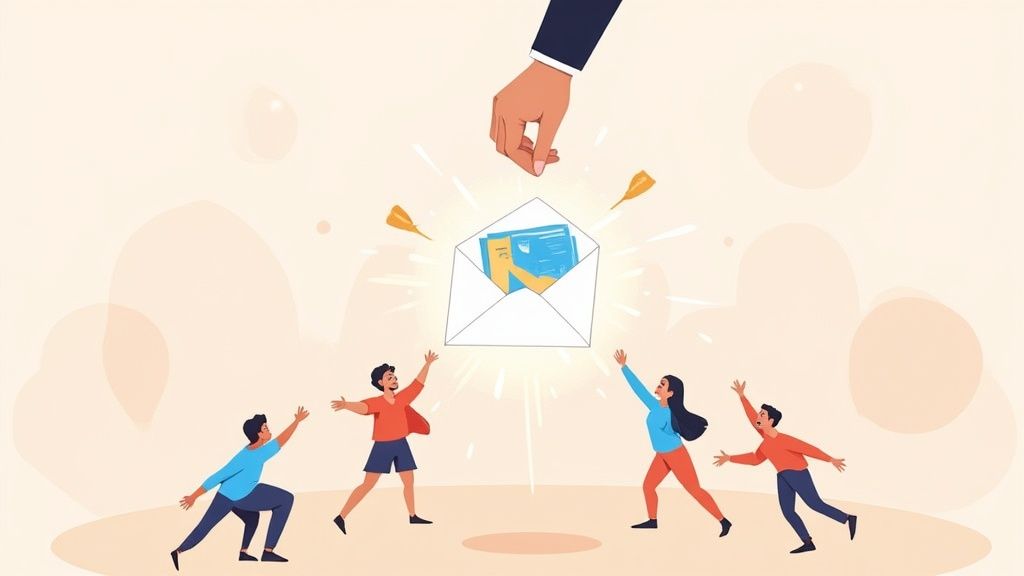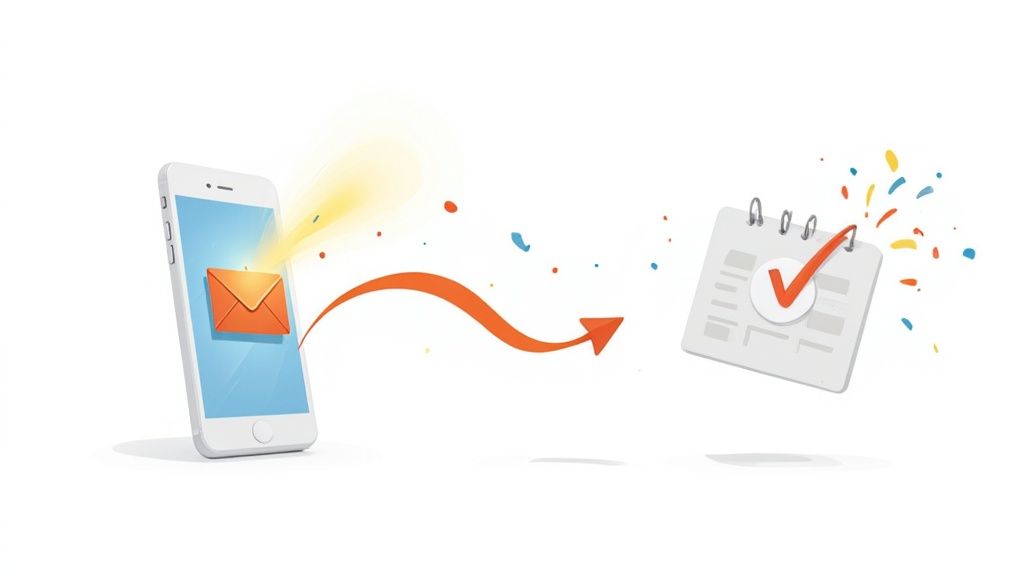So, you need to send an RSVP email. Getting it right is about more than just passing along information; it's the very first touchpoint of your event experience. A sloppy or confusing email? That’s a one-way ticket to a planning headache and a low response rate.
The real trick is to find that sweet spot between giving people all the details they need and keeping the message short and scannable.
Let's face it, your guests are busy people with overflowing inboxes. A great RSVP email cuts through the noise by putting the most important info—the classic who, what, when, where, and why—right at the top.
Crafting an RSVP Email That Gets a Reply
Every RSVP email that actually gets a response is built on the same foundation. Nailing these core elements is the difference between getting quick, clean confirmations and having to chase people down with follow-up after follow-up.
Here’s what every single invitation needs to include:
- A Compelling Subject Line: This is your first impression, so make it count. Be clear but also add a little excitement. Think "You're Invited: Annual Marketing Summit 2024" or "RSVP by Oct 25 for Our Team Holiday Party."
- Clear Event Details: Don't make people hunt for the basics. The event name, date, time, and location need to be front and center, right at the top of the email.
- A Firm Deadline: A clear "RSVP by" date does wonders. It creates a natural sense of urgency and is absolutely critical for finalizing your headcount. Without it, you’ll have responses trickling in forever.
- An Obvious Call-to-Action (CTA): This should be the most eye-catching thing in the email. Whether it’s a big button that says "Confirm Your Spot" or a simple, clear link, there should be no question about what to do next.
The number one goal of an RSVP email is to eliminate all friction. If a guest has to spend more than 30 seconds figuring out how to respond, you've probably already lost them. Simplicity is your best friend here.
Anatomy of a High-Converting RSVP Email
To make this even easier, think of your email like a checklist. Here’s a quick breakdown of the essential parts, what they do, and how to get them right.
| Component | Purpose | Best Practice Example |
|---|---|---|
| Clear Subject Line | Grab attention and convey the email's purpose instantly. | You're Invited! RSVP for the Event Name |
| Personalized Greeting | Make the recipient feel personally invited, not just part of a mass email. | Hi First Name, |
| Essential Details | Provide all necessary information upfront (What, When, Where). | Join us for our Annual Gala on October 26, 2024, at 7:00 PM at The Grand Venue. |
| Brief Event Context | Give a short, engaging reason for the event (the "Why"). | We're celebrating a year of success and would love for you to be there. |
| Clear CTA Button/Link | Make it incredibly easy to respond. | A bold button that says: Click Here to RSVP |
| RSVP Deadline | Create a sense of urgency and help with planning. | Please let us know if you can make it by October 15, 2024. |
| Closing & Signature | End the email professionally and provide contact info for questions. | Best regards, The Your Company Team |
Getting these pieces in place ensures your guests feel informed and valued, which is exactly the vibe you want.
At the end of the day, a solid grasp of the fundamentals of RSVP in email communication sets you up for success with any event, whether it's a casual webinar or a formal corporate gala.
Mastering Your Invitation Timeline and Etiquette
Knowing what to say in your invitation is half the battle. Knowing when to send it is the other half. Timing is everything. Send it too early, and it gets forgotten. Send it too late, and you’ll be staring at an empty guest list because of scheduling conflicts.
For most events, the sweet spot is sending the initial invitation four to six weeks in advance. This gives people enough runway to check their calendars and make plans, but it’s not so far out that the invite gets lost in the digital abyss of their inbox.
Of course, if you're planning something bigger and more formal, like a conference or a wedding, you'll want to extend that timeline. For those, aim for eight to twelve weeks out. It's just good practice.
Finding the RSVP Sweet Spot
Once the invitations are out, the waiting game begins. Understanding when you can realistically expect replies is key to managing your own planning timeline without pulling your hair out.
We’ve seen some fascinating data from over half a million digital RSVPs. It turns out, there's a pretty clear pattern. The bulk of responses—about 57.6%—roll in within the first five weeks. The real peak hits around Week 3, which accounts for 13% of all responses. A good rule of thumb is that you’ll have heard from about half your guests by the four-and-a-half-week mark. If you want to dive deeper into the numbers, you can check out the full research on wedding RSVP response times.
So what actually gets people to click that "Yes" button? This chart breaks it down perfectly.

It really boils down to three pillars: a killer subject line, a crystal-clear call-to-action, and a firm deadline. Nail those three, and you're well on your way to a great response rate.
Handling Reminders and Late Replies
Even with the most perfectly timed invitation, you're always going to have stragglers. It’s just human nature. A polite reminder email, sent about a week before your RSVP deadline, is the perfect way to give them a gentle nudge.
Pro Tip: Keep your reminder short, sweet, and friendly. Seriously, something as simple as, "Just a friendly reminder to RSVP for Event Name by Date" usually does the trick.
And for those who inevitably reply after the deadline? Handle it with grace. Whether you can squeeze them in or not, a positive response keeps the relationship intact for next time.
RSVP Email Templates for Different Occasions
Knowing the theory behind a good RSVP email is one thing, but seeing it in action is another. A solid template doesn't just save you time; it makes sure you don't forget any of the important stuff.
The real trick is matching your tone to the event. What works for a formal corporate summit is going to feel completely out of place for a casual team lunch.
Let's walk through a few examples you can steal and adapt for your next event.
The Formal Corporate Event
Think conferences, galas, or award ceremonies. For these, your tone needs to be professional, respectful, and crystal clear. You want to convey the importance of the event and make your guest feel genuinely valued.
Subject: An Invitation to the Company Name Annual Leadership Summit
Body:
Dear Guest Name,
We are pleased to invite you to the annual Event Name on Date at Time, held at Venue.
This year's summit will bring together industry leaders to discuss briefly state the event's purpose or theme. Your presence would be a great addition to this important conversation.
Please confirm your attendance by RSVP Date so we can finalize arrangements.
RSVP Now Button
We look forward to welcoming you.
Sincerely,
The Company Name Team
The Casual Team Get-Together
When you're inviting colleagues to something more relaxed, like a holiday party or a team-building day, you can loosen up and be much more conversational.
Subject: You’re Invited! Let's Celebrate a Great Quarter!
Body:
Hi team,
To celebrate all our hard work this quarter, we're having a team lunch at Restaurant Name on Date at Time!
Get ready for some great food and even better company. Please let us know if you can make it by RSVP Date so we can give the restaurant a headcount.
Click Here to RSVP
Can't wait to see you there!
Best,
Your Name/Team Lead
Key Takeaway: The basic structure is the same, but the language changes everything. The formal template uses phrases like "pleased to invite" and signs off with "sincerely." The casual one jumps right in with exclamation points and a friendlier, more direct tone.
While these templates are a great starting point for that initial RSVP request, a truly compelling invitation involves a bit more strategy. For a deeper dive, you might want to check out our complete guide on creating a sample event invitation email.
The Professional Webinar
For virtual events, absolute clarity is king. Your email has to do double duty: secure the RSVP and make it painfully obvious how people can join the session.
Subject: Register Now: Mastering Webinar Topic
Body:
Hi First Name,
Join us for our upcoming webinar, Webinar Title, on Date at Time. We’ll be covering key takeaway 1, key takeaway 2, and key takeaway 3.
This session is perfect for anyone looking to achieve a specific goal.
Save your spot today to receive the unique joining link.
Register Here Button
We hope to see you online!
The Your Company Team
Proven Strategies to Boost Your Response Rates
Getting a reply is about more than just sending an email. It's about making it ridiculously easy for your guests to say "yes." A few thoughtful tweaks to your approach can make a world of difference, improving your results and making the whole planning process a lot smoother.
The most powerful strategy? Personalization. It sounds simple, but just using a guest's first name in the subject line can make your email pop in a crowded inbox. It instantly changes the message from a generic blast into a personal invitation, which builds a connection right away.

Simplify the Response Process
Think about it: the easier it is to reply, the more replies you'll get. Every single extra click or form field you add is a point of friction, a tiny hurdle where a potential attendee might just give up and move on.
Here’s how you can cut through that friction:
- One-Click Responses: Instead of asking guests to reply to the email or fill out a long form, give them simple "Yes" or "No" buttons that link directly to a confirmation page. It's fast and definitive.
- Minimal Form Fields: If you absolutely need more information, only ask for what's essential right now. A name and email are usually plenty for an initial confirmation.
- Mobile-Friendly Design: Make sure your email and any linked pages look great and function perfectly on a phone. So many people will see your invite and RSVP while they're on the go.
The core idea here is to remove any and all mental barriers. If someone can confirm their attendance in under 10 seconds, you're on the right track. The goal is a completely frictionless experience.
This focus on simplicity has a huge impact. Response rates for events typically hover between 60% to 85%, but emails with personalized subject lines can see a 50% higher open rate. That sets you up for success before they've even seen the event details.
Of course, none of these strategies will work if your email never makes it to the inbox. To make sure your invitations actually get seen, check out our guide on email deliverability best practices.
Let Automation Handle Your RSVP Workflow
If you've ever managed RSVPs manually, you know the pain. It’s a fast track to headaches and mistakes, especially as your event gets bigger. Trying to keep track of a spreadsheet, chasing people for replies, and sending out individual reminders isn't just a time-sink—it’s a clunky way to handle a critical piece of your event. This is exactly where automation can step in and save the day.

Instead of blasting out emails one by one, you can lean on tools to manage the entire process. For instance, our service, Add to Calendar PRO, lets you create sleek event landing pages that already have RSVP forms built right in. Every single response is tracked automatically in one central dashboard, giving you a live headcount without you having to do a thing.
Make It Effortless for Everyone
One of the biggest wins with automation is just how smooth it makes the experience for your guests. When someone says they’re coming, a good system doesn’t just mark them as "attending" and call it a day. It should immediately give them a way to get that event onto their personal calendar.
With our tool, the moment a guest RSVPs, they can add the event to their Google Calendar, Outlook, or Apple Calendar with a single click. It's a small step, but it's a huge weapon against no-shows because it locks their commitment right into their schedule.
An automated workflow doesn't just save you hours of work; it presents a polished, professional image to your guests from the very first touchpoint. It tells them you're organized and that you value their time.
The real magic of an RSVP email is often in the follow-up. Some interesting research shows that a simple reminder email sent two weeks before the deadline can boost response rates by up to 20%. Automated systems are brilliant at this, sending targeted nudges only to the people who haven't replied yet. If you want to dig deeper into the numbers, Eventbookings.com has a great breakdown on the impact of RSVP email automation.
Answering Your Most Common RSVP Questions
Even with the best-laid plans, managing event invites always throws a few curveballs. Knowing how to handle the common hiccups will save you a ton of time and keep your communication sharp. Let's tackle a few of the questions we hear all the time.
First up, timing. When is the perfect time to send that email? While every audience is a little different, the data generally points to the middle of the week.
We've found that Tuesday, Wednesday, and Thursday mornings (think around 10 AM in your guest's time zone) consistently get the best engagement. You're dodging the Monday morning inbox avalanche and the Friday afternoon pre-weekend checkout.
Navigating Tricky Guest Scenarios
Another one we hear a lot: how do you deal with no-shows? It’s a classic frustration when someone RSVPs "yes" but then ghosts you on the day of the event.
To cut down on this, we're big fans of the "final details" reminder email. Send it out 24-48 hours before the event kicks off. It's a simple, polite nudge that confirms the schedule and directions, and it works wonders. After the event, sending a follow-up with a summary or a recording is a great touch for both attendees and those who couldn't make it, keeping your brand top-of-mind.
What about text messages for reminders? It's a great question, but our advice is to tread carefully. A text can be super effective for close contacts or as a last-ditch, urgent reminder if a deadline is seconds away. For most formal or corporate events, though, it can feel a bit intrusive. The reminder email is almost always the safer, more professional bet.
At the end of the day, a smooth RSVP process comes down to clear communication and making things dead simple for your guests. From the first invite to the final reminder, every interaction should be straightforward and respectful of their time. By thinking through these common questions, you can fine-tune your approach and send an RSVP email that actually gets results.
Ready to take the manual work out of your event planning? Our service, Add to Calendar PRO, offers automated RSVP tracking, beautiful event landing pages, and one-click calendar buttons to boost attendance and save you hours. Learn more and get started today.



